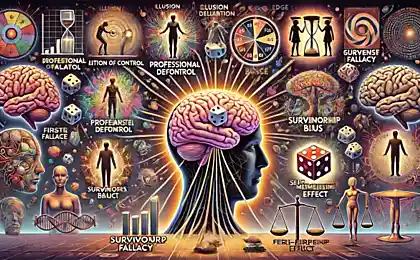480
Bugs thinking: 9 cognitive errors that distort our reality
Seventy one million one hundred ninety eight thousand five hundred forty nine
The appeal of rhyme, manipulation of choice, Stockholm syndrome buyer and emotional shortsightedness. The effect of the rhyme
We unconsciously tend to believe almost any proposition more credible if it is written in rhyme, this technique of persuasion used by psychologists-manipulators in the TV series "Mind Games". This effect is confirmed by numerous studies where a group of people were asked to identify the degree of confidence to a variety of rhymed and unrhymed phrases. Sentences that contain rhyming, are noticeably more attractive to the subjects and cause them to have more confidence. For example, the phrase "what sobriety conceals, alcohol reveals" was recognized more convincing than the thesis of "Sobriety hides what brings out the alcohol." The effect can be triggered by the fact that the rhyme facilitates cognitive processes and is associated in our subconscious seemingly disparate parts of the proposal.
The effect of an anchor Many people use first catching them in the eye information and make further conclusions about something just based on it. Once a person "sets the anchor", he makes judgments, not trying to look a little further conditional "Parking lot". If subjects to offer five seconds to estimate the approximate mathematical result of the example 1×2 x 3×4 x 5×6 × 7×8 = ? then for lack of time, most people will Peremoga the first few numbers and saw that the figure was not too large, will announce a modest final result (the average response is about 512). But if the sequence of multipliers swap: 8×7 × 6×5 x 4×3 x 2×1 — subject, after the first few steps, and seeing that the result of the multiplication turns out great, will significantly increase their forecasts of the final response (the average response is about 2250). The correct result of multiplication — 40 320.
The availability heuristic If you ask a College student: "In your school learns more and more students from Colorado or California?"then his answer would most likely be based on the personal examples that he can remember for a short period of time. The easier we can remember something, the more we trust this knowledge. If you ask a person a question: "We took a random word: do you think it is more likely to start with a letter K, or this letter will be the third?"the majority of people are much faster to recall words beginning with K, not words, where K is the third letter, and give your answer based on this. In fact, the standard text contains twice as many words where K is in third place.
Stockholm syndrome buyer Often consciousness retroactively ascribe positive qualities to that object that the person has already chosen and purchased, and to refuse which cannot. For example, if you bought a computer from Apple, then you probably won't notice or will significantly primarysite disadvantages of computers of the company and, on the contrary, significantly increase criticism of Windows-based computers. The buyer will do its utmost to justify bought the product without noticing its shortcomings, even if they are substantial and the choice is not up to his expectations. This syndrome explains the purchase on a "me in this will be much better when I lose weight."
The effect of bait If a consumer is faced with a choice — to buy cheaper and less capacious player or A more expensive and more capacious player B, someone will prefer a device with more capacity, and some low price. But if the game takes the player, which is more expensive than A and B, and has more memory than A but less than B, then by the very fact of its existence, it increases the chances of player B and makes it a favorite among the trio. This is due to the fact that the buyer sees that the model with a large amount of storage may cost less, and it subconsciously affects his choice. The only purpose of these lures is to persuade the person in favor of one of the two options. This scheme is valid not only in marketing.
The IKEA effect of Giving an undue value to the things in which participates by the customer himself. Many of the items produced by the furniture store IKEA, require the buyer to build at home, and this is no coincidence: the user appreciates the product a lot more when it sees it and his work. Experiments have shown that people are willing to pay more for thing gathered himself, than that thing that needs no Assembly, and believes that it is better and more reliable.
"Hot — cold" Biased assessment of the validity that arise because of the inability to imagine yourself in a different state and predict their behavior in a situation associated with this condition. For example, when a person is hot, it is difficult to understand the charm of coolness and when he is madly in love, he can't remember how I lived without passion. Such short-sightedness leads to reckless actions: until we are faced with a really serious temptation, it seems to us that it is not so difficult to resist.
Functional fixation is a Mental block against the new approach to the use of the object: staples for fastening sheets of paper, a hammer — to hammer in a nail. This distortion does not allow our consciousness to move away from the original purpose of the items and to see all possible additional functions. The classic experiment confirming this phenomenon, an experiment with a candle. Give participants a candle, a box office buttons and matches and asked to attach the candle to the wall so that it is not dripping on the table. Few participants can "rethink" a box of buttons, to make her a stand for candles, instead of trying to attach candle to the wall using the buttons.
Belief in a just world Have a quite positive tendency to hope for the best there is a dark side: because people find it very difficult to accept the fact that the world is unfair and full of accidents, they're trying to find logic in the most absurd and terrible events. Which in turn leads to bias. Therefore, victims of crimes often are charged that they by their actions have contributed to such behavior on the part of the perpetrator (a classic example is the approach "my fault" for victims of rape).
Source: theoryandpractice.ru
The appeal of rhyme, manipulation of choice, Stockholm syndrome buyer and emotional shortsightedness. The effect of the rhyme
We unconsciously tend to believe almost any proposition more credible if it is written in rhyme, this technique of persuasion used by psychologists-manipulators in the TV series "Mind Games". This effect is confirmed by numerous studies where a group of people were asked to identify the degree of confidence to a variety of rhymed and unrhymed phrases. Sentences that contain rhyming, are noticeably more attractive to the subjects and cause them to have more confidence. For example, the phrase "what sobriety conceals, alcohol reveals" was recognized more convincing than the thesis of "Sobriety hides what brings out the alcohol." The effect can be triggered by the fact that the rhyme facilitates cognitive processes and is associated in our subconscious seemingly disparate parts of the proposal.
The effect of an anchor Many people use first catching them in the eye information and make further conclusions about something just based on it. Once a person "sets the anchor", he makes judgments, not trying to look a little further conditional "Parking lot". If subjects to offer five seconds to estimate the approximate mathematical result of the example 1×2 x 3×4 x 5×6 × 7×8 = ? then for lack of time, most people will Peremoga the first few numbers and saw that the figure was not too large, will announce a modest final result (the average response is about 512). But if the sequence of multipliers swap: 8×7 × 6×5 x 4×3 x 2×1 — subject, after the first few steps, and seeing that the result of the multiplication turns out great, will significantly increase their forecasts of the final response (the average response is about 2250). The correct result of multiplication — 40 320.
The availability heuristic If you ask a College student: "In your school learns more and more students from Colorado or California?"then his answer would most likely be based on the personal examples that he can remember for a short period of time. The easier we can remember something, the more we trust this knowledge. If you ask a person a question: "We took a random word: do you think it is more likely to start with a letter K, or this letter will be the third?"the majority of people are much faster to recall words beginning with K, not words, where K is the third letter, and give your answer based on this. In fact, the standard text contains twice as many words where K is in third place.
Stockholm syndrome buyer Often consciousness retroactively ascribe positive qualities to that object that the person has already chosen and purchased, and to refuse which cannot. For example, if you bought a computer from Apple, then you probably won't notice or will significantly primarysite disadvantages of computers of the company and, on the contrary, significantly increase criticism of Windows-based computers. The buyer will do its utmost to justify bought the product without noticing its shortcomings, even if they are substantial and the choice is not up to his expectations. This syndrome explains the purchase on a "me in this will be much better when I lose weight."
The effect of bait If a consumer is faced with a choice — to buy cheaper and less capacious player or A more expensive and more capacious player B, someone will prefer a device with more capacity, and some low price. But if the game takes the player, which is more expensive than A and B, and has more memory than A but less than B, then by the very fact of its existence, it increases the chances of player B and makes it a favorite among the trio. This is due to the fact that the buyer sees that the model with a large amount of storage may cost less, and it subconsciously affects his choice. The only purpose of these lures is to persuade the person in favor of one of the two options. This scheme is valid not only in marketing.
The IKEA effect of Giving an undue value to the things in which participates by the customer himself. Many of the items produced by the furniture store IKEA, require the buyer to build at home, and this is no coincidence: the user appreciates the product a lot more when it sees it and his work. Experiments have shown that people are willing to pay more for thing gathered himself, than that thing that needs no Assembly, and believes that it is better and more reliable.
"Hot — cold" Biased assessment of the validity that arise because of the inability to imagine yourself in a different state and predict their behavior in a situation associated with this condition. For example, when a person is hot, it is difficult to understand the charm of coolness and when he is madly in love, he can't remember how I lived without passion. Such short-sightedness leads to reckless actions: until we are faced with a really serious temptation, it seems to us that it is not so difficult to resist.
Functional fixation is a Mental block against the new approach to the use of the object: staples for fastening sheets of paper, a hammer — to hammer in a nail. This distortion does not allow our consciousness to move away from the original purpose of the items and to see all possible additional functions. The classic experiment confirming this phenomenon, an experiment with a candle. Give participants a candle, a box office buttons and matches and asked to attach the candle to the wall so that it is not dripping on the table. Few participants can "rethink" a box of buttons, to make her a stand for candles, instead of trying to attach candle to the wall using the buttons.
Belief in a just world Have a quite positive tendency to hope for the best there is a dark side: because people find it very difficult to accept the fact that the world is unfair and full of accidents, they're trying to find logic in the most absurd and terrible events. Which in turn leads to bias. Therefore, victims of crimes often are charged that they by their actions have contributed to such behavior on the part of the perpetrator (a classic example is the approach "my fault" for victims of rape).
Source: theoryandpractice.ru
6 simple but effective ways to wrap an unpleasant situation to their advantage
The mystery of Gagarin's death may be revealed























